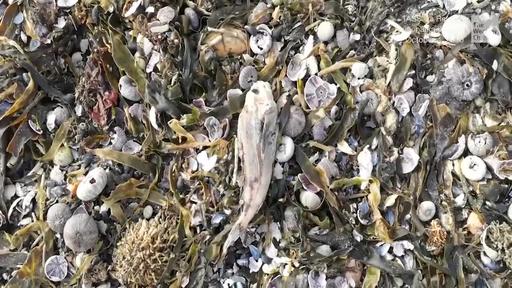Mass die-off along Russian coast concerns environmentalists

Deceased sea life on the shore of Kamchatka.
At the beginning of October, pictures began emerging on the internet depicting a Russian shore covered in dead sea creatures.
Discovered near Kamchatka, a Russian Pacific coastal town, scientists and environmentalists are left dumbstruck by how an event like this occurred, with an estimated 95% death rate of creatures living 10-15 meters below the surface, according to ABC News.
Kelly Pearce, assistant professor of Environmental Science and Sustainability, expressed that the situation reminded her somewhat of the Exxon Valdez oil spill that occurred in 1989, though primarily out of concern for the area’s ecosystem.
“Large-scale deaths are really worrying,” Pearce said. “Anytime you have a mass die-off, the ability for an ecosystem to recover from that is really limited because it wipes out all the individuals in these populations.”
According to ABC, the most likely cause was toxins released by blooming algae or seismic activity. While man-made causes are not completely ruled out, the Kamchatka government website claims that the disaster was natural in origin.
“One of the first things I thought was that maybe it was related to a harmful algae bloom,” Pearce said. “We often get those like off the coast of Florida and on the Gulf Coast. You get these influxes of chemicals that reduce oxygen availability and as a result, algae blooms. So that was my first thought, that maybe it was related to a high hypoxia — or low oxygen — event.”
Speculation continues to occur about the true cause, though, as the area had multiple purposes during the time of the Soviet Union. The area was — and still is — used for naval drill practicing, seeing use as recently as early August. The Soviets also stored over 100 tons of chemicals and pesticides in a nearby facility, which recently faced a fencing breach, according to ABC.
“When I looked into it a little bit more, I thought that it was much more related to a man-made cause rather than more natural events,” Pearce said. “Two things really pointed me towards the man-made. One, that it was so extensive. Ninety-five percent of the sea life was killed and during hypoxia events, typically the larger sea life is able to swim away from the situation at a quicker rate. Then also the indication that humans that were in the water were also experiencing burns.”
Pearce explained that in almost every circumstance, it is impossible for algae to cause chemical burns of that type on humans.
“That makes me believe that this is much, much more likely related to some chemical or pesticide spill that’s occurring in the area,” Pearce said. “I’m concerned (with) how they’re going to clean up if it was a man-made spill. Sometimes it takes years for these chemicals to fully break down.”
Greenpeace, an environmental protection organization, has been monitoring the situation as it develops.
“For now, none of the theories has been confirmed,” said Elena Sakirko, a member of Greenpeace, in an interview with ABC. “We think the checks are insufficient. They should have probed for pesticides.”
The consequences following the die-off may stretch past the beach and have negative implications for Kamchatka as well.
“It’s going to take time for new individuals to migrate back to the system,” Pearce said. “This area might just be a dead zone for 10 or 15 years, not allowing any life. That is really concerning, especially if people in the area depend on this for food sources, like if people fish in the area.”
Aside from fishing, Pearce explained that the loss of physical space could be detrimental to citizens and tourists alike.
“I read that this is a common area for people to go swimming and surfing,” Pearce said. “So just losing that human connection to the area is concerning as well.”
Depending on whether the die-off was caused by a man-made toxin of some kind may also have potential impacts on portions of the sea below the 10-15 meter range where most of the death occurred.
“Most of the life in the ocean lives on that top 10 to 15 meters because that’s where the sun penetrates,” Pearce said. “So that’s where the food — the primary productivity — is. If these fish or materials were contaminated and they die and sink down, bigger predators and other species that may eat these individuals could also then get poisoned, so there may be some bioaccumulation that could potentially occur.”
Pearce explained that the potential impacts of this and similar events exemplify the need for honesty and action — specifically among governments — in order to combat future occurrences.
“This highlights the importance of transparency within our governments, because when things like this happen, an immediate response is really needed,” Pearce said. “Rather than being upfront with where the source of the pollution is, they are kind of trying to hide it, it seems like. So I think that transparency — whether it’s a private organization or the government — is really important in terms of responding quickly to these situations.”

Roman Hladio is a senior from Wexford, Pennsylvania. He is studying English with a creative writing emphasis, and completing requirements for a Journalism...




